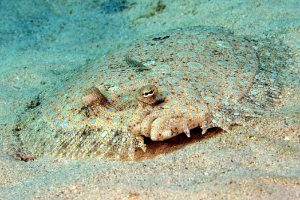
Peacock Flounder
Flounders are a group of flatfish species belonging to the family Pleuronectidae. They are known for their unique body shape, which is flat and horizontally compressed, with both eyes on one side of the head. Here are some interesting facts about flounders:
Body Structure: Flounders have a distinct body shape that allows them to lie flat on the ocean floor. They have both eyes positioned on one side of their body, usually the right side, while the other side is usually white or pale in color. This adaptation enables them to camouflage effectively and blend with the sandy or muddy ocean bottom.
Camouflage and Coloration: Flounders are masters of camouflage. They can change their skin color and pattern to match their surroundings, making them nearly invisible to both predators and prey. Their ability to blend with the environment helps them ambush prey and evade detection.
Feeding Behavior: Flounders are carnivorous predators that primarily feed on small fish, crustaceans, and invertebrates. They are ambush predators, lying motionless on the ocean floor and using their well-developed eyesight to detect movement. Once prey is spotted, flounders quickly strike and engulf it in their large mouths.
Habitat and Distribution: Flounders are found in both saltwater and brackish water environments. They inhabit a wide range of habitats, including sandy or muddy bottoms, estuaries, coastal areas, and sometimes even deeper offshore waters. Flounders have a global distribution, with different species found in various oceans and seas around the world.
Life Cycle and Reproduction: Flounders undergo a remarkable metamorphosis as they develop. When they hatch, they have a typical fish body shape with eyes on each side of the head. As they grow, one eye migrates to the other side, and the body becomes flat and asymmetric. Flounders reproduce through external fertilization, with females releasing eggs and males releasing sperm into the water column.
Commercial and Recreational Fishing: Flounders are commercially and recreationally important fish species. They are valued for their delicate and mild-flavored meat. Many anglers target flounders for sport fishing, as they can provide an exciting challenge due to their unique feeding behavior and ability to camouflage.
Conservation Status: The conservation status of flounders varies among species and regions. Some flounder populations face threats such as habitat destruction, over fishing, and pollution. Sustainable fishing practices and the protection of critical habitats are crucial for maintaining healthy flounder populations.